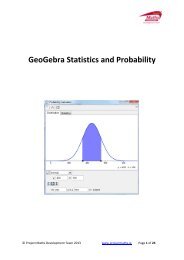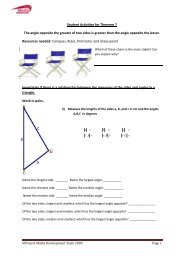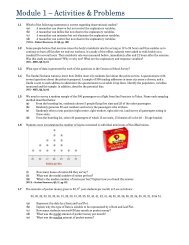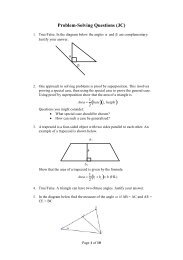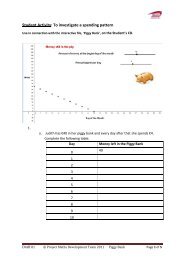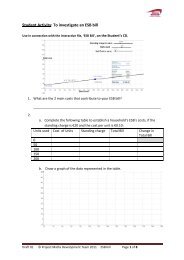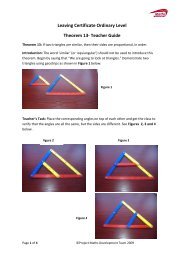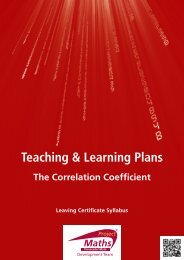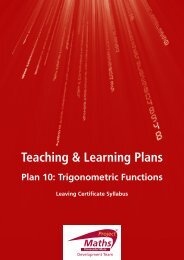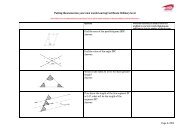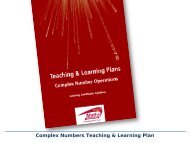Teaching & Learning Plans - Project Maths
Teaching & Learning Plans - Project Maths
Teaching & Learning Plans - Project Maths
Create successful ePaper yourself
Turn your PDF publications into a flip-book with our unique Google optimized e-Paper software.
<strong>Teaching</strong> & <strong>Learning</strong> <strong>Plans</strong><br />
The Multiplication<br />
of Fractions<br />
Junior Certificate Syllabus
The <strong>Teaching</strong> & <strong>Learning</strong> <strong>Plans</strong><br />
are structured as follows:<br />
Aims outline what the lesson, or series of lessons, hopes to achieve.<br />
Prior Knowledge points to relevant knowledge students may already have and also<br />
to knowledge which may be necessary in order to support them in accessing this new<br />
topic.<br />
<strong>Learning</strong> Outcomes outline what a student will be able to do, know and understand<br />
having completed the topic.<br />
Relationship to Syllabus refers to the relevant section of either the Junior and/or<br />
Leaving Certificate Syllabus.<br />
Resources Required lists the resources which will be needed in the teaching and<br />
learning of a particular topic.<br />
Introducing the topic (in some plans only) outlines an approach to introducing the<br />
topic.<br />
Lesson Interaction is set out under four sub-headings:<br />
i. Student <strong>Learning</strong> Tasks – Teacher Input: This section focuses on teacher input<br />
and gives details of the key student tasks and teacher questions which move the<br />
lesson forward.<br />
ii.<br />
Student Activities – Possible and Expected Responses: Gives details of<br />
possible student reactions and responses and possible misconceptions students<br />
may have.<br />
iii. Teacher’s Support and Actions: Gives details of teacher actions designed to<br />
support and scaffold student learning.<br />
iv.<br />
Checking Understanding: Suggests questions a teacher might ask to evaluate<br />
whether the goals/learning outcomes are being/have been achieved. This<br />
evaluation will inform and direct the teaching and learning activities of the next<br />
class(es).<br />
Student Activities linked to the lesson(s) are provided at the end of each plan.
<strong>Teaching</strong> & <strong>Learning</strong> <strong>Plans</strong>: The<br />
Multiplication of Fractions<br />
Aims<br />
• To consolidate students’ understanding of the multiplication of fractions<br />
• To engage students with the everyday uses of fractions<br />
• To engage students in activities that will help to reinforce the multiplication<br />
algorithm<br />
Prior Knowledge<br />
Students should have prior knowledge of some terms and ideas associated with fractions<br />
from the primary school curriculum, but the topic may need to be revisited to ensure<br />
that all students know the basics. Students may have certain ‘misconceptions’ based on<br />
intuition and personal experience. Students should be familiar with:<br />
• the ordering of fractions<br />
• the equivalence of fractions<br />
• the addition and subtraction of fractions – using fraction strips, fraction<br />
circles and symbols<br />
• the multiplication of whole numbers as “groups of “<br />
• the fraction wall (Appendix 1)<br />
Your attention is drawn to “An Overview of <strong>Teaching</strong> & <strong>Learning</strong> Fractions” below:<br />
© <strong>Project</strong> <strong>Maths</strong> Development Team 2009 www.projectmaths.ie 1
<strong>Teaching</strong> & <strong>Learning</strong> Plan: The Multiplication of Fractions<br />
<strong>Learning</strong> Outcomes<br />
As a result of studying this topic, students will be able to<br />
• multiply a whole number by a fraction and understand the procedure<br />
• multiply a fraction by a whole number and understand the procedure<br />
• multiply a fraction by a fraction and understand the procedure<br />
• use the algorithm of multiplying numerators and denominators together<br />
and also be able to model what is happening<br />
• appreciate that multiplication does not always make things bigger<br />
Catering for Learner Diversity<br />
In class, the needs of all students, whatever their level of ability, are equally important. In<br />
daily classroom teaching, teachers can cater for different abilities by providing students<br />
with different activities and assignments graded according to levels of difficulty so that<br />
students can work on exercises that match their progress in learning. Some students<br />
may only be able to engage in activities which are relatively straightforward, while<br />
others may be able to engage in more open-ended and challenging activities. Selecting<br />
and assigning activities appropriate to a student’s ability will cultivate and sustain his/<br />
her interest in learning.<br />
In this T & L Plan, students might be required to draw, provide a verbal explanation,<br />
compose a multiplication sentence, apply the algorithm. Teachers can provide students<br />
with various amounts and different styles of support during the class.<br />
In interacting with the whole class, teachers can employ effective and inclusive<br />
questioning. Questions can be pitched at different levels and can move from basic<br />
questioning to ones which are of a higher order nature. In this T & L Plan, some students<br />
may be required to answer a question such as: Aoife works during her summer<br />
holidays for 4 hours on Saturdays and earns €12 per hour. How much does<br />
she earn each Saturday? A more challenging question can be reserved for others:<br />
Can you explain in words how the multiplication algorithm works? Sometimes<br />
students might be asked to devise a question themselves or to see if they could come<br />
up with an alternative question to one they might have been asked.<br />
Besides whole-class teaching, teachers can consider different grouping strategies – such<br />
as group and pair work – to encourage student interaction, help students to verbalise<br />
their mathematical understanding and help to build student self-confidence and<br />
mathematical understanding. For example, in this T & L Plan students are asked to work<br />
in pairs to make up a question where the number line could be used for multiplication,<br />
do out a solution and swap their question with another pair; they can then be asked to<br />
compare answers.<br />
© <strong>Project</strong> <strong>Maths</strong> Development Team 2010 www.projectmaths.ie 2
<strong>Teaching</strong> & <strong>Learning</strong> Plan: The Multiplication of Fractions<br />
Relationship to Junior Certificate Syllabus<br />
Topic Number Description of topic<br />
Students learn about<br />
3.1 Number<br />
Systems<br />
Q: The set of<br />
rational<br />
numbers<br />
The binary operations<br />
of addition, subtraction,<br />
multiplication and division and<br />
the relationships between these<br />
operations, beginning with<br />
whole numbers and integers.<br />
They explore some of the laws<br />
that govern these operations<br />
and use mathematical models<br />
to reinforce the algorithms<br />
they commonly use. Later, they<br />
revisit these operations in the<br />
context of rational numbers and<br />
irrational numbers (R/Q) and<br />
refine, revise and consolidate<br />
their ideas.<br />
Students learn strategies for<br />
computation that can be applied<br />
to any numbers; implicit in such<br />
computational methods are<br />
generalisations about numerical<br />
relationships with the operations<br />
being used. Students articulate<br />
the generalisation that underlies<br />
their strategy, firstly in the<br />
vernacular and then in symbolic<br />
language.<br />
Problems set in context, using<br />
diagrams to solve the problems<br />
so they can appreciate how<br />
the mathematical concepts are<br />
related to real life. Algorithms<br />
used to solve problems involving<br />
fractional amounts.<br />
<strong>Learning</strong> outcomes<br />
Students should be able to<br />
• investigate models to help<br />
think about the operations<br />
of addition, subtraction,<br />
multiplication and division<br />
of rational numbers<br />
• analyse solution strategies<br />
to problems<br />
Resources Required<br />
Fraction strips, fraction circles, fraction stacks (optional), number lines, area model and<br />
fraction wall (Appendix1).<br />
© <strong>Project</strong> <strong>Maths</strong> Development Team 2010 www.projectmaths.ie 3
<strong>Teaching</strong> & <strong>Learning</strong> Plan: The Multiplication of Fractions<br />
Student <strong>Learning</strong> Tasks: Teacher<br />
Input<br />
»»<br />
We are going to look at multiplying<br />
a whole number by a fraction.<br />
»»<br />
Firstly, we will look at whole<br />
number multiplication to examine<br />
what is happening in this number<br />
operation.<br />
»»<br />
For example, Liz wants to give each<br />
of her 3 friends 4 bars.<br />
»»<br />
How would you work out how many<br />
bars she needs?<br />
»»<br />
Can you draw a picture to model<br />
this situation?<br />
Lesson Interaction<br />
Student Activities: Possible<br />
and Expected Responses<br />
Teacher’s Support and<br />
Actions<br />
• 3 x 4 bars = 12 bars »»<br />
Emphasise to students that<br />
multiplication is repeated<br />
addition.<br />
• Students may draw<br />
»»<br />
If they do this i.e.<br />
X<br />
X<br />
Checking<br />
Understanding<br />
»»<br />
Can students<br />
give<br />
examples<br />
to show<br />
that they<br />
understand<br />
that “a x b"<br />
means<br />
“a groups of<br />
b”?<br />
• Students now draw<br />
ask them to think in terms<br />
of putting the bars into a<br />
bag for each friend and<br />
then draw a picture.<br />
»»<br />
Can you now put your picture into<br />
words?<br />
• Liz needs 3 groups of 4 bars<br />
each for her friends.<br />
» » Draw this picture on the<br />
board “3 groups of 4 bars”<br />
© <strong>Project</strong> <strong>Maths</strong> Development Team 2010 www.projectmaths.ie KEY: » next step • student answer/response 4
<strong>Teaching</strong> & <strong>Learning</strong> Plan: The Multiplication of Fractions<br />
Student <strong>Learning</strong> Tasks:<br />
Teacher Input<br />
»»<br />
What does the notation<br />
3 x 4 mean?<br />
Student Activities: Possible<br />
and Expected Responses<br />
• It means 4 + 4 + 4.<br />
Teacher’s Support and<br />
Actions<br />
Checking Understanding<br />
• It means 3 times 4.<br />
»»<br />
Now we are going to take<br />
an example of multiplying<br />
a whole number by a<br />
fraction.<br />
»»<br />
Barry is having 4 of his<br />
friends over to his house<br />
for pizza. He is going to<br />
give them ⅔ of a pizza<br />
each.<br />
• ⅔ + ⅔ + ⅔ + ⅔<br />
or<br />
• 4x ⅔<br />
or<br />
• 4 groups of ⅔ each<br />
»»<br />
How is this like the last<br />
problem?<br />
»»<br />
Can you model the<br />
situation using fraction<br />
circles?<br />
•<br />
»»<br />
Remind students that the<br />
amount in each group stays<br />
the same.<br />
» » Draw the picture of the<br />
pizzas on the board and<br />
write:<br />
“4 groups of ⅔”<br />
© <strong>Project</strong> <strong>Maths</strong> Development Team 2010 www.projectmaths.ie KEY: » next step • student answer/response 5
<strong>Teaching</strong> & <strong>Learning</strong> Plan: The Multiplication of Fractions<br />
Student <strong>Learning</strong> Tasks:<br />
Teacher Input<br />
»»<br />
Can you put your picture<br />
into words?<br />
Student Activities: Possible<br />
and Expected Responses<br />
• 4 groups of ⅔<br />
Teacher’s Support and<br />
Actions<br />
»»<br />
Allow students time<br />
to either draw, add or<br />
multiply to get their<br />
answer.<br />
Checking Understanding<br />
»»<br />
4 groups of ⅔ is equal to<br />
how many thirds?<br />
• 8/3 (there are 3 ways<br />
students can get this<br />
answer...draw, add or<br />
multiply)<br />
»»<br />
Circulate and check<br />
students’ progress.<br />
»»<br />
Are students counting from<br />
their circles, adding<br />
⅔ + ⅔ + ⅔ + ⅔ or<br />
multiplying ⅔ by 4?<br />
»»<br />
Are students still relying on<br />
pictures or are they coming<br />
up with an algorithm?<br />
»»<br />
Pick 3 students who got the<br />
answer of 8/3 by<br />
1. counting the shaded thirds<br />
in the picture<br />
2. adding or<br />
3. multiplying.<br />
»»<br />
Ask these students to<br />
present their answers to<br />
the class.<br />
» Allow students time<br />
to either draw, add or<br />
multiply to get their<br />
answer.<br />
»»<br />
How many pizzas do you<br />
think Barry would need for<br />
his friends?<br />
• 2 ⅔ pizzas.<br />
» Circulate.<br />
» Pick 3 students who got the<br />
answer of 2 ⅔ by<br />
1. counting the shaded thirds<br />
in the picture or<br />
2. adding or<br />
3. multiplying.<br />
© <strong>Project</strong> <strong>Maths</strong> Development Team 2010 www.projectmaths.ie KEY: » next step • student answer/response 6
<strong>Teaching</strong> & <strong>Learning</strong> Plan: The Multiplication of Fractions<br />
Student <strong>Learning</strong> Tasks: Teacher<br />
Input<br />
Student Activities: Possible<br />
and Expected Responses<br />
• One of the above<br />
students may draw the<br />
picture below on the<br />
board<br />
Teacher’s Support and<br />
Actions<br />
Checking Understanding<br />
= 2 ⅔<br />
• Another student may add<br />
⅔ + ⅔ + ⅔ + ⅔<br />
and get 8/3= 2 ⅔<br />
»»<br />
So you have written how you<br />
would write 4 groups of ⅔ as a<br />
multiplication sentence.<br />
»»<br />
Make a poster of another<br />
example like this one using<br />
words, pictures, multiplication<br />
sentences and a real world<br />
situation.<br />
»»<br />
Could anyone come to the top of<br />
the class to discuss their poster,<br />
remembering to include:<br />
1. words<br />
2. pictures<br />
3. multiplication sentences<br />
4. real world situations ?<br />
• A third student may use a<br />
multiplication sentence:<br />
4 x ⅔ = 8/3 = 2⅔<br />
»»<br />
In pairs, can students<br />
come up with other<br />
examples like this one?<br />
• Students present their<br />
posters to the class.<br />
»»<br />
Allow discussion and<br />
comments from the class<br />
as to why the example is a<br />
good one or, perhaps, why<br />
it may cause confusion.<br />
» » Did students come up<br />
with other (varied)<br />
suggestions, other than<br />
circles (e.g. cakes, apple<br />
tarts, etc.)?<br />
© <strong>Project</strong> <strong>Maths</strong> Development Team 2010 www.projectmaths.ie KEY: » next step • student answer/response 7
<strong>Teaching</strong> & <strong>Learning</strong> Plan: The Multiplication of Fractions<br />
Student <strong>Learning</strong> TasksTeacher Input Student Activities: Possible and<br />
Expected Responses<br />
»»<br />
If I ask you to multiply ⅔ by 4, what<br />
incorrect answer do you think I<br />
could get?<br />
(A possible incorrect answer could be)<br />
• ⅔ x 4 = 8/12<br />
Teacher’s Support<br />
and Actions<br />
»»<br />
Allow time for<br />
students to<br />
think.<br />
Checking Understanding<br />
»»<br />
Note: if for example 8/12 is offered as<br />
an incorrect answer, facilitate the<br />
discussion.<br />
»»<br />
Why is this incorrect?<br />
• 8/12 = ⅔ and we multiplied ⅔<br />
by 4 to get 8/12, so 8/12 cannot be<br />
the answer to ⅔ x 4.<br />
or<br />
• We added up ⅔ four times. We<br />
were adding up thirds–the size<br />
of the part didn’t change, just<br />
the number of them changed.<br />
»»<br />
Accept all<br />
answers and<br />
write them on<br />
the board.<br />
»»<br />
Allow students<br />
to discuss why<br />
some of the<br />
answers are<br />
incorrect.<br />
»»<br />
Circulate and<br />
make sure<br />
everyone is<br />
clear on what<br />
to do.<br />
»»<br />
Can students see why<br />
4 x ⅔ = 8/3 and not<br />
8/12 ? This is a common<br />
misconception?<br />
»»<br />
Students need to present<br />
more examples like this<br />
and verbalise why the<br />
answer is as it should be.<br />
»»<br />
Based on what has been done,<br />
write a question for the person<br />
sitting beside you, do out the<br />
solution, come up with an incorrect<br />
solution and be able to explain to<br />
your partner why this answer is<br />
incorrect.<br />
»»<br />
Students work on writing<br />
out a question, its solution<br />
and an incorrect solution and<br />
then pass the question to the<br />
student beside them.<br />
»»<br />
Now swap your questions.<br />
»»<br />
Explain the answer to each other.<br />
»»<br />
Students check to see if they<br />
got the answer correct.<br />
»»<br />
Check to see if your answers agree.<br />
»»<br />
Can you explain why the incorrect<br />
answer is incorrect?<br />
© <strong>Project</strong> <strong>Maths</strong> Development Team 2010 www.projectmaths.ie KEY: » next step • student answer/response 8
<strong>Teaching</strong> & <strong>Learning</strong> Plan: The Multiplication of Fractions<br />
Student <strong>Learning</strong> Tasks:<br />
Teacher Input<br />
»»<br />
Try this question:<br />
Sharon does ¾ of an hour<br />
of homework every night<br />
for 5 nights. How much<br />
homework does she do<br />
altogether?<br />
You are to use<br />
words, pictures and a<br />
multiplication sentence.<br />
Student Activities: Possible and<br />
Expected Responses<br />
Teacher’s Support and Actions<br />
Checking<br />
Understanding<br />
»»<br />
Allow students time to think<br />
»»<br />
Circulate<br />
»»<br />
As you check on students’<br />
progress, ask 3 students if<br />
they would come to the<br />
board and present their work;<br />
one to present it in words,<br />
one the picture and one the<br />
multiplication sentence.<br />
»»<br />
Allow students time to write,<br />
draw and verbalise their<br />
answers to the class.<br />
(Although, many students will<br />
be able to do this without the<br />
fraction strips or circles, using<br />
them helps to consolidate the<br />
concepts.)<br />
• Words: 5 groups of ¾ =15/4<br />
• Picture:<br />
= ¾ + ¾ + ¾ + ¾ + ¾ = 15/4<br />
(Repeated Addition)<br />
or<br />
= 3 ¾<br />
• Multiplication sentence:<br />
5 x ¾ = 15/4<br />
© <strong>Project</strong> <strong>Maths</strong> Development Team 2010 www.projectmaths.ie KEY: » next step • student answer/response 9
Student <strong>Learning</strong> Tasks:<br />
Teacher Input<br />
»»<br />
We will now look at the<br />
fraction multiplication<br />
algorithm. Up to now, we<br />
haven’t written the whole<br />
number as a fraction over 1.<br />
»»<br />
For a number to remain the<br />
same, what do we multiply<br />
or divide it by?<br />
»»<br />
So for the denominator to<br />
remain the same what do<br />
we multiply it by?<br />
»»<br />
How can we write 5 as a<br />
fraction?<br />
»»<br />
Could you rewrite the<br />
problem 5 x ¾ to show this?<br />
(Students would have been<br />
introduced to this concept<br />
in primary school.)<br />
»»<br />
Can you explain to each<br />
other how to multiply<br />
5/1 x ¾ using the<br />
multiplication algorithm.<br />
»»<br />
Can you explain in words<br />
how the multiplication<br />
algorithm works?<br />
<strong>Teaching</strong> & <strong>Learning</strong> Plan: The Multiplication of Fractions<br />
Student Activities:<br />
Possible and<br />
Expected Responses<br />
• 1<br />
• Multiply it by 1<br />
• 5/1<br />
Teacher’s Support and<br />
Actions<br />
»»<br />
Ask students for more<br />
examples of this and<br />
write them on the board<br />
e.g. 4x1=4<br />
7x1=7<br />
»»<br />
Ask for more examples<br />
• 5/1 x ¾ »»<br />
Ask for a few more<br />
examples from the<br />
students (highlighting<br />
this concept may be<br />
helpful).<br />
• You multiply the<br />
two numerators<br />
together and<br />
divide it by the<br />
two denominators<br />
multiplied<br />
together to get 15/4<br />
»»<br />
Note: Delay providing<br />
the answer for as long as<br />
possible.<br />
Checking Understanding<br />
»»<br />
Have the students understood the<br />
multiplication algorithm as:<br />
a/b x c/d = (a×c)/(b×d)<br />
»»<br />
Can students apply what they have<br />
learned about the multiplication<br />
algorithm to similar questions?<br />
»»<br />
Note: From now on questions will be<br />
done using words, pictures, multiplication<br />
sentences and algorithms.<br />
© <strong>Project</strong> <strong>Maths</strong> Development Team 2010 www.projectmaths.ie KEY: » next step • student answer/response 10
<strong>Teaching</strong> & <strong>Learning</strong> Plan: The Multiplication of Fractions<br />
Student <strong>Learning</strong> Tasks:<br />
Teacher Input<br />
Student Activities: Possible and<br />
Expected Responses<br />
Teacher’s Support and<br />
Actions<br />
Checking Understanding<br />
»»<br />
From Student Activity<br />
1, complete Q1, 2 and<br />
3.<br />
»»<br />
Distribute Student Activity<br />
1 and ask students to<br />
answer Q1, 2, and 3.<br />
»»<br />
Circulate and check<br />
progress<br />
»»<br />
Ask different students if<br />
they will present their work<br />
to the class.<br />
»»<br />
Students present their work to<br />
the class.<br />
»»<br />
Check questions on the<br />
board, questioning where<br />
necessary.<br />
»»<br />
Can students verbalise<br />
their answers at the<br />
board.<br />
»»<br />
Go to Student<br />
Activity 1, Q4 (i) and<br />
(ii).<br />
»»<br />
Circulate and check<br />
students’ progress.<br />
»»<br />
Ask a student to present<br />
their answer to part (i)<br />
using the number line.<br />
»»<br />
Let’s look at Q4 (i).<br />
»»<br />
A student draws the following on<br />
the board: Time worked in hours<br />
1<br />
hour<br />
2<br />
hours<br />
3<br />
hours<br />
4<br />
hours<br />
0 12 24 36 48<br />
»»<br />
How much does she<br />
earn?<br />
• 4 hours at €12 per hour<br />
(4 groups of 12) = €48<br />
»»<br />
Write on the board<br />
(4 hours x €12 = €12 + €12<br />
+ €12 + €12)<br />
» » Can the students<br />
recognise that this is<br />
repeated addition?<br />
(4 hours x €12 = €12 +<br />
€ 12 + €12 + €12)<br />
© <strong>Project</strong> <strong>Maths</strong> Development Team 2010 www.projectmaths.ie KEY: » next step • student answer/response 11
<strong>Teaching</strong> & <strong>Learning</strong> Plan: The Multiplication of Fractions<br />
Student <strong>Learning</strong> Tasks:<br />
Teacher Input<br />
»»<br />
What does the picture<br />
show?<br />
Student Activities: Possible<br />
and Expected Responses<br />
• A jump from 0 to the first tick<br />
represents an hour of work<br />
and I write in 12 at this tick<br />
mark to show how much is<br />
earned after 1 hour.<br />
Teacher’s Support and<br />
Actions<br />
Checking Understanding<br />
»»<br />
Can students verbalise<br />
their picture?<br />
• A jump from 1 to the second<br />
tick represents another hour<br />
of work and I write in 24 at<br />
this tick mark to show how<br />
much is earned after 2 hours,<br />
and so on for 3 and 4 until I<br />
get €48.<br />
• 2 hours x €12 = €24<br />
• 3 hours x €12 = €36<br />
• 4 hours x €12 = €48<br />
• 5 hours x €12 = €60<br />
»»<br />
What did you get for the<br />
multiplication sentences in<br />
Q4 (ii)?<br />
»»<br />
Write the multiplication<br />
sentences on the board:<br />
2 hours x €12 = €24<br />
3 hours x €12 = €36<br />
4 hours x €12 = €48<br />
5 hours x €12 = €60<br />
»»<br />
Now, in pairs, make up<br />
a question where the<br />
number line could be used<br />
for multiplication?<br />
»»<br />
Do out a solution.<br />
»»<br />
Swap your question with<br />
another pair when you<br />
have it completed and<br />
compare answers.<br />
»»<br />
In pairs, can students<br />
make up other questions<br />
where the number<br />
line could be used for<br />
multiplication?<br />
» » Did students come up<br />
with varied suggestions<br />
other than hours and<br />
money?<br />
© <strong>Project</strong> <strong>Maths</strong> Development Team 2010 www.projectmaths.ie KEY: » next step • student answer/response 12
<strong>Teaching</strong> & <strong>Learning</strong> Plan: The Multiplication of Fractions<br />
Student <strong>Learning</strong> Tasks:<br />
Teacher Input<br />
»»<br />
Look at Q4 (iii).<br />
Student Activities: Possible<br />
and Expected Responses<br />
Teacher’s Support and<br />
Actions<br />
»»<br />
As you check on students’<br />
progress, ask 3 students if<br />
they would come to the<br />
board to present their<br />
work; one to present<br />
using the picture, one the<br />
multiplication sentence<br />
and one using the<br />
multiplication algorithm.<br />
»»<br />
Emphasise to students that<br />
multiplication is repeated<br />
addition.<br />
Checking Understanding<br />
»»<br />
Staying in your pairs,<br />
explain to each other how<br />
you would find out how<br />
much money Aoife will<br />
earn in 2½ hours?<br />
»»<br />
Can students verbalise their<br />
answer?<br />
• Picture:<br />
Mark the number line<br />
halfway between 2 and 3.<br />
See how much money this<br />
represents<br />
€12 + €12 + €6 = €30<br />
• Multiplication sentence:<br />
2½ lots of €12 = €24 + €6<br />
= €30<br />
• Algorithm:<br />
5/2 x 12 = 5/2 x 12/1 = 60/2 = €30<br />
»»<br />
Note: While students<br />
may not convert 2½ to<br />
an improper fraction<br />
they should be able to<br />
work this out without the<br />
conversion.<br />
» » Can students convert 2½ to<br />
an improper fraction?<br />
© <strong>Project</strong> <strong>Maths</strong> Development Team 2010 www.projectmaths.ie KEY: » next step • student answer/response 13
<strong>Teaching</strong> & <strong>Learning</strong> Plan: The Multiplication of Fractions<br />
Student <strong>Learning</strong> Tasks:<br />
Teacher Input<br />
»»<br />
Let’s discuss Student<br />
Activity 1,Q4 (iv ).<br />
Student Activities: Possible<br />
and Expected Responses<br />
Teacher’s Support and<br />
Actions<br />
»»<br />
Give students time to draw<br />
or calculate this. (Some<br />
students will model this by<br />
drawing the number line<br />
and dividing the interval<br />
from 0 to 12 into quarters.<br />
They will see that each<br />
quarter of an hour Aoife<br />
earns €12/4 and for ¾ she<br />
earns 3 x 12/4. Others will<br />
use an algorithm.)<br />
Checking Understanding<br />
»»<br />
How much money will<br />
Aoife earn in ¾ of an<br />
hour?<br />
Note: Students should<br />
think of ¾ as three one<br />
quarters. Find the ¼ first<br />
and then get 3 times that.<br />
»»<br />
Some students will be<br />
able to do this without<br />
the picture (number line),<br />
but practice with an easy<br />
question will help them<br />
to use the number line for<br />
more complex problems.<br />
»»<br />
Will it be bigger or<br />
smaller than €12?<br />
• It will be less than €12.<br />
or<br />
• 1 times 12 is 12 and as ¾<br />
is less than 1, ¾ x 12 will<br />
be less than 12.<br />
» » Can students appreciate why the<br />
answer is less than 12?<br />
© <strong>Project</strong> <strong>Maths</strong> Development Team 2010 www.projectmaths.ie KEY: » next step • student answer/response 14
<strong>Teaching</strong> & <strong>Learning</strong> Plan: The Multiplication of Fractions<br />
Student <strong>Learning</strong> Tasks:<br />
Teacher Input<br />
»»<br />
If you wish model this<br />
using the number line.<br />
Student Activities: Possible<br />
and Expected Responses<br />
»»<br />
Note: Students could draw<br />
the following:<br />
Teacher’s Support and<br />
Actions<br />
»»<br />
Write on the board:<br />
Amount of money earned<br />
in euro is<br />
¾ x 12 = €9<br />
Checking Understanding<br />
0 12 24<br />
3 6 9<br />
• ¾ hour x €12/1 = 36/4 = €9<br />
»»<br />
Write down the<br />
multiplication sentence,<br />
the algorithm and the<br />
answer.<br />
»»<br />
Did multiplication by ¾<br />
make €12 bigger?<br />
• ¾ x 12/1 = 36/4 = €9<br />
• No, multiplication by a<br />
number less than 1 made<br />
€12 smaller.<br />
»»<br />
Students verbalise other<br />
instances<br />
»»<br />
Write on the board:<br />
Multiplication doesn’t<br />
always make things bigger.<br />
»»<br />
Write students examples on<br />
the board<br />
»»<br />
Make up examples of<br />
other instances where<br />
multiplication doesn’t<br />
make things bigger<br />
»»<br />
Ask a student to explain in<br />
words how you get ¾ x 12.<br />
»»<br />
Did students come up with<br />
other (varied) suggestions?<br />
• You found how much she<br />
earned in ¼ of an hour so<br />
you divided 12 by 4, giving<br />
€3 and then for ¾ of an<br />
hour it was 3 times this<br />
which gives €9. Multiplying<br />
by ¾ is dividing by 4 and<br />
multiplying by 3.<br />
»»<br />
Have students understood<br />
this concept that ¾<br />
means dividing by 4 and<br />
multiplying by 3?<br />
»»<br />
Would it matter in which<br />
order you do the question?<br />
1. ¾ x 12 or<br />
2. 12 x ¾<br />
Try both.<br />
• ¾ x 12 = 9<br />
• 12 x ¾ = 36/4 = 9 also. So No.<br />
» » Allow students time to<br />
think and verbalise their<br />
answers to the class.<br />
Write on board:<br />
¾ x 12 = 9<br />
12 x ¾ = 36/4 = 9<br />
© <strong>Project</strong> <strong>Maths</strong> Development Team 2010 www.projectmaths.ie KEY: » next step • student answer/response 15
<strong>Teaching</strong> & <strong>Learning</strong> Plan: The Multiplication of Fractions<br />
Student <strong>Learning</strong> Tasks:<br />
Teacher Input<br />
»»<br />
Can you verbalise in terms<br />
of groups what each<br />
question means?<br />
Student Activities: Possible<br />
and Expected Responses<br />
• One is ¾ of a group of 12<br />
whereas the other is 12<br />
groups of ¾.<br />
Teacher’s Support and<br />
Actions<br />
Checking Understanding<br />
»»<br />
Draw a picture to show<br />
each of these situations.<br />
»»<br />
Students draw pictures to<br />
show that ¾ of a group<br />
of 12 is equivalent to 12<br />
groups of ¾.<br />
»»<br />
Now complete Student<br />
Activity 1: Q5 & Q6.<br />
»»<br />
Circulate and check<br />
progress.<br />
»»<br />
Check questions on the<br />
board, questioning where<br />
necessary.<br />
»»<br />
Now let’s have a look at<br />
multiplying a fraction by a<br />
fraction.<br />
»»<br />
Cara had 2/5 of her<br />
“rectangular” birthday<br />
cake left over from her<br />
party. She ate ¾ of the<br />
leftover cake. How much of<br />
the full cake did she eat?<br />
»»<br />
Think about what you are<br />
being asked?<br />
• What is ¾ of 2/5 of a whole<br />
cake?<br />
» » Can students verbalise this<br />
question?<br />
© <strong>Project</strong> <strong>Maths</strong> Development Team 2010 www.projectmaths.ie KEY: » next step • student answer/response 16
<strong>Teaching</strong> & <strong>Learning</strong> Plan: The Multiplication of Fractions<br />
Student <strong>Learning</strong> Tasks:<br />
Teacher Input<br />
»»<br />
Answer this question<br />
using a picture, a<br />
multiplication sentence<br />
and the multiplication<br />
algorithm.<br />
Student Activities: Possible<br />
and Expected Responses<br />
Teacher’s Support and Actions<br />
Checking<br />
Understanding<br />
»»<br />
Can students<br />
verbalise their<br />
answer?<br />
»»<br />
Can you explain to me<br />
what you have drawn?<br />
• I drew a rectangle to<br />
represent the whole cake.<br />
I divided it vertically into 5<br />
equal parts and shaded in<br />
the amount left over after<br />
the party.<br />
»»<br />
As you check on students’ progress<br />
ask 2 students if they would come to<br />
the board and present their work; one<br />
to present using the picture, one the<br />
multiplication sentence/ multiplication<br />
algorithm.<br />
»»<br />
Students may be unsure of how to<br />
make the division but there will<br />
probably be someone who comes<br />
up with it. It is better not to tell the<br />
students how to do it but let them find<br />
it for themselves.<br />
Note: Students can also be given a<br />
rectangular strip of paper and they can<br />
fold the paper vertically first into fifths<br />
and then horizontally into quarters.<br />
»»<br />
Do students<br />
understand that<br />
fractions must<br />
be related to a<br />
referent whole<br />
i.e. the original<br />
rectangle/cake?<br />
(This is a very<br />
important point<br />
for students to<br />
understand)<br />
» » Can students show<br />
that the whole<br />
cake needs to<br />
be divided into<br />
quarters?<br />
»»<br />
Can you explain to me<br />
what this represents?<br />
• I divided the whole cake<br />
horizontally into 4 equal<br />
parts.<br />
»»<br />
How many equal parts<br />
are there now?<br />
• 20<br />
© <strong>Project</strong> <strong>Maths</strong> Development Team 2010 www.projectmaths.ie KEY: » next step • student answer/response 17
<strong>Teaching</strong> & <strong>Learning</strong> Plan: The Multiplication of Fractions<br />
Student <strong>Learning</strong> Tasks:<br />
Teacher Input<br />
Student Activities: Possible<br />
and Expected Responses<br />
Teacher’s Support and<br />
Actions<br />
»»<br />
Some students see the<br />
algorithm straight away<br />
and others maybe not. It<br />
is better to have students<br />
point it out to the teacher<br />
than the other way around.<br />
Checking Understanding<br />
»»<br />
Can you explain to me<br />
what this represents?<br />
»»<br />
How many pieces are there<br />
in the shaded area?<br />
»»<br />
What fraction of the whole<br />
are they?<br />
• I marked off ¾ of the<br />
previously shaded amount.<br />
I marked off ¾ of 2/5. This is<br />
the part eaten by Cara.<br />
• 6 pieces<br />
• 6 out of 20<br />
»»<br />
Are students able to model<br />
multiplication of a fraction<br />
by a fraction using an area<br />
model?<br />
»»<br />
Can students see that<br />
multiplying tops and<br />
bottoms has a foundation<br />
in reality? The product ¾ of<br />
2/5 means that if we divided<br />
the 2/5 of the remaining<br />
cake into 4 equal parts<br />
then ¾ of 2/5 is the amount<br />
given by 3 of those equal<br />
parts.<br />
»»<br />
Write the answer as a<br />
multiplication sentence/<br />
algorithm.<br />
• ¾ x 2/5 = 6/20<br />
»»<br />
Using your knowledge of<br />
equivalent fractions, can<br />
you simplify this fraction?<br />
• 6/20 = 3/10 if we divide<br />
the numerator and<br />
denominator by 2.<br />
»»<br />
Now complete Student<br />
Activity 1: Q7.<br />
»»<br />
Circulate and check<br />
progress.<br />
» » Check questions on the<br />
board, questioning where<br />
necessary.<br />
© <strong>Project</strong> <strong>Maths</strong> Development Team 2010 www.projectmaths.ie KEY: » next step • student answer/response 18
<strong>Teaching</strong> & <strong>Learning</strong> Plan: The Multiplication of Fractions<br />
Student <strong>Learning</strong> Tasks:<br />
Teacher Input<br />
Reflection:<br />
»»<br />
Write down 3 things you<br />
learned about multiplying<br />
fractions today.<br />
Student Activities: Possible<br />
and Expected Responses<br />
How to:<br />
1. Multiply a whole number<br />
by a fraction<br />
2. Multiply a fraction by a<br />
whole number<br />
Teacher’s Support and<br />
Actions<br />
Checking Understanding<br />
3. Multiply a fraction by a<br />
fraction<br />
4. Pictures, multiplication<br />
sentences and algorithms<br />
can be very helpful when<br />
multiplying fractions.<br />
5. Multiplication algorithm<br />
for multiplying two<br />
fractions can be<br />
generalised as:<br />
a/b x c/d = (a×c)/(b×d)<br />
»»<br />
Write down anything you<br />
found difficult today.<br />
»»<br />
Write down any questions<br />
you may have.<br />
6. Multiplication does not<br />
always make things bigger.<br />
» » Circulate and take note of<br />
any questions or difficulties<br />
students have noted and<br />
help them to answer them.<br />
© <strong>Project</strong> <strong>Maths</strong> Development Team 2010 www.projectmaths.ie KEY: » next step • student answer/response 19
1. The unit is<br />
<strong>Teaching</strong> & <strong>Learning</strong> Plan: The Multiplication of Fractions<br />
Student Activity 1<br />
Picture<br />
Words. The above diagrams show ________groups of ________<br />
Multiplication sentence: ____x_____=________<br />
Algorithm ______________________________________________________________________<br />
2. Fill in the blank spaces below. When the answers are improper<br />
fractions, change them into proper fractions.<br />
Multiplication<br />
Sentence<br />
4 x = 5/6<br />
Words Picture Algorithm Answer<br />
3 groups of 5/8<br />
3. Mentally picture the following problems before calculating the<br />
answers:<br />
(i) 8 x 2/3 = (ii) 5 x 3/11 = (iii) 6 x 5/8 =<br />
© <strong>Project</strong> <strong>Maths</strong> Development Team 2010 www.projectmaths.ie 20
<strong>Teaching</strong> & <strong>Learning</strong> Plan: The Multiplication of Fractions<br />
Student Activity 1<br />
4. Aoife works during her Summer holidays for 4 hours on<br />
Saturdays and earns €12 per hour.<br />
(i) How much does she earn each Saturday ?<br />
Hint: If €12, the amount earned in 1 hour, is represented by the first tick mark after 0<br />
on the number line below, mark in the amount earned after 2, 3, and 4 hours.<br />
Model the situation on the number line<br />
0 1 Time in hours<br />
0 12<br />
Amount of money earned in euro<br />
(ii) Write the multiplication sentence for the amount earned in<br />
2 hours ___________ 3 hours ____________ 4 hours ____________ 5 hours ____________<br />
(iii) How much money will Aoife earn in 2½ hours?<br />
Model the situation on the number line<br />
0 1 Time in hours<br />
0 12<br />
Amount of money earned in euro<br />
Multiplication sentence__________________________________________________________<br />
Algorithm______________________________________________________________________<br />
(iv) Use the number line to model the amount Aoife earns in ¾ hr?<br />
Model the situation on the number line<br />
0 12<br />
Multiplication sentence for the amount earned in ¾ of an hour____________________<br />
Algorithm______________________________________________________________________<br />
© <strong>Project</strong> <strong>Maths</strong> Development Team 2010 www.projectmaths.ie 21
<strong>Teaching</strong> & <strong>Learning</strong> Plan: The Multiplication of Fractions<br />
Student Activity 1<br />
5. There are 24 students in Mary’s class. 5/6 of the class<br />
went on the school trip. How many students from<br />
Mary’s class went on the school trip?<br />
Model the situation on the number line<br />
0<br />
Multiplication sentence____________________________________________________________<br />
Algorithm________________________________________________________________________<br />
6. David picks strawberries during the summer holidays.<br />
He earns €8 for each basket of strawberries he picks.<br />
How much does he earn if he picks 2¼ baskets of<br />
strawberries?<br />
Model the situation on the number line<br />
0<br />
Multiplication sentence____________________________________________________________<br />
Algorithm________________________________________________________________________<br />
7. Tony tiled 4/5 of a bathroom wall. Next day he grouted 7/8<br />
of the tiled section. What fraction of the bathroom wall<br />
had the tiles grouted?<br />
Model this using an area model<br />
Multiplication sentence____________________________________________________________<br />
Algorithm________________________________________________________________________<br />
© <strong>Project</strong> <strong>Maths</strong> Development Team 2010 www.projectmaths.ie 22
<strong>Teaching</strong> & <strong>Learning</strong> Plan: The Multiplication of Fractions<br />
Fraction Wall<br />
1 unit or 1 “whole”<br />
1/2 1/2<br />
1/3 1/3 1/3<br />
¼ ¼ ¼ ¼<br />
1/5 1/5 1/5 1/5 1/5<br />
1/6 1/6 1/6 1/6 1/6 1/6<br />
1/7 1/7 1/7 1/7 1/7 1/7 1/7<br />
1/8 1/8 1/8 1/8 1/8 1/8 1/8 1/8<br />
1/9 1/9 1/9 1/9 1/9 1/9 1/9 1/9 1/9<br />
1/10 1/10 1/10 1/10 1/10 1/10 1/10 1/10 1/10 1/10<br />
1/11 1/11 1/11 1/11 1/11 1/11 1/11 1/11 1/11 1/11 1/11<br />
1/12 1/12 1/12 1/12 1/12 1/12 1/12 1/12 1/12 1/12 1/12 1/12<br />
1/15 1/15 1/15 1/15 1/15 1/15 1/15 1/15 1/15 1/15 1/15 1/15 1/15 1/15 1/15<br />
1/16 1/16 1/16 1/16 1/16 1/16 1/16 1/16 1/16 1/16 1/16 1/16 1/16 1/16 1/16 1/16<br />
1/18 1/18 1/18 1/18 1/18 1/18 1/18 1/18 1/18 1/18 1/18 1/18 1/18 1/18 1/18 1/18 1/18 1/18<br />
1/20 1/20 1/20 1/20 1/20 1/20 1/20 1/20 1/20 1/20 1/20 1/20 1/20 1/20 1/20 1/20 1/20 1/20 1/20 1/20<br />
1/24 1/24 1/24 1/24 1/24 1/24 1/24 1/24 1/24 1/24 1/24 1/24 1/24 1/24 1/24 1/24 1/24 1/24 1/24 1/24 1/24 1/24 1/24 1/24<br />
© <strong>Project</strong> <strong>Maths</strong> Development Team 2010 www.projectmaths.ie 23



